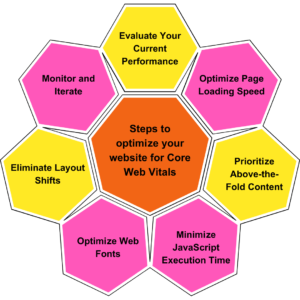Having a website that performs well is crucial for online success. User experience is a key factor in determining the success of your website, and one of the most important aspects of user experience is page speed. Core Web Vitals, a set of metrics introduced by Google, focus on the user-centric performance of a website. In this blog post, we will explore the significance of Core Web Vitals and provide you with practical tips to optimize your website for optimal performance and a seamless user experience.
Steps to optimize your website for Core Web Vitals:

Evaluate Your Current Performance:
Use tools like Google PageSpeed Insights, Lighthouse, or WebPageTest to assess your website’s current performance. These tools will provide valuable insights into your website’s Core Web Vitals scores and identify areas that need improvement.
Optimize Page Loading Speed:
To improve your LCP score, focus on optimizing your page loading speed. Compress and optimize images, leverage browser caching, minify CSS and JavaScript files, and use a content delivery network (CDN) to reduce server response times.
Prioritize Above-the-Fold Content:
Ensure that the above-the-fold content of your web pages loads quickly. This can be achieved by deferring non-critical JavaScript, CSS, and third-party scripts. By doing so, you prioritize the content that users see first, improving both LCP and FID scores.
Minimize JavaScript Execution Time:
Excessive JavaScript execution can cause delays in interactivity, impacting FID. Minimize the use of render-blocking JavaScript and defer non-essential scripts to allow for faster interactivity.
Optimize Web Fonts:
Web fonts can significantly impact page loading speed. Consider using font-display: swap to ensure that text is displayed while custom fonts load. Additionally, limit the number of font styles and variants to reduce the overall font file size.
Eliminate Layout Shifts:
To improve your CLS score, eliminate unexpected layout shifts. Reserve space for ads and images to prevent content from shifting when they load. Use CSS properties like aspect ratio, fixed dimensions, or placeholder elements to preserve the layout during page rendering.
Monitor and Iterate:
Regularly monitor your website’s Core Web Vitals using Google Search Console or other performance monitoring tools. Continuously optimize and iterate based on the insights and recommendations provided.
Optimizing your website for Core Web Vitals is essential for enhancing user experience, improving search engine rankings, and ultimately driving more traffic and conversions. By following the steps outlined in this guide, you can ensure that your website meets the performance standards set by Google. Stay proactive in monitoring your Core Web Vitals and consistently work on optimizing your website to provide a fast, seamless, and delightful user experience. Remember, a fast website is a key ingredient for online success in today’s digital world.
Optimize your website’s Core Web Vitals and boost its performance – contact us now!







